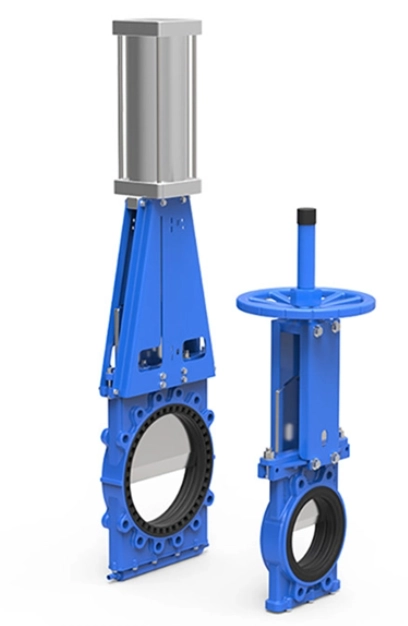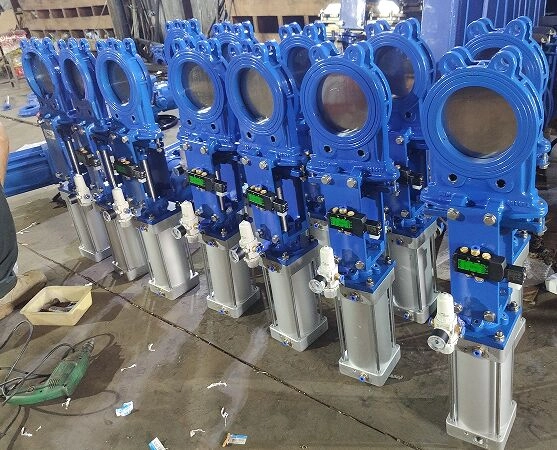close
Choose Your Site
Global
Social Media
Views: 0 Author: Site Editor Publish Time: 2025-07-02 Origin: Site











Ever wonder how large pipes control heavy fluids with just air?Pneumatic gate valves do exactly that—fast, clean, and powerful.These valves use compressed air to move a gate and stop or start flow.They’re used in water, oil, gas, and power systems around the world.In this post, you’ll learn how pneumatic gate valves work and why they matter.
A pneumatic gate valve is a shut-off valve that uses compressed air to move a gate up and down. It opens or closes the flow path in a pipeline by lifting or lowering a metal plate (gate) inside. These valves are ideal for fast, reliable control in industrial systems transporting liquids, gases, or slurries.
They’re especially useful where manual operation is unsafe or slow. Because air is clean and fast-moving, pneumatic valves respond quickly and work well in automated setups.
Let’s compare pneumatic gate valves with manual and electric ones.
Type | Actuation Method | Pros | Cons |
Handwheel | Simple, low-cost | Slow, not ideal for automation | |
Electric | Motor-driven actuator | Accurate, programmable | Risky in explosive environments |
Pneumatic | Compressed air | Fast, clean, safe for hazardous areas | Needs constant air supply |
Key Advantages of Pneumatic Operation:
● Very fast actuation
● Great for hazardous environments (no sparks)
● Less moving parts = lower maintenance
● Works with remote control systems
Pneumatic valves come in various gate designs:
Gate Type | Description | Best For |
Solid Wedge | One solid gate piece | General-purpose fluids |
Flexible Wedge | Slightly bendable for better sealing | Thermal cycling applications |
Split Wedge | Two-part gate for misaligned seats | Steam, gas |
Parallel Slide | Flat plates sliding together | Low-pressure or viscous media |
Knife Gate (link) | Sharp edge cuts through thick slurry | Mining, pulp, wastewater |

● Valve Body: External shell that connects to the pipeline
● Gate (Disc or Wedge): Blocks or allows fluid flow
● Valve Seat: Surface the gate presses against to seal
● Stem: Links actuator to the gate
● Bonnet: Covers the stem; may be open or sealed
Part | Function |
Cylinder | Holds piston, chamber for air pressure |
Piston & Rod | Moves vertically as air enters/leaves |
Valve Stem Interface | Connects piston rod to valve stem |
Air Ports | Control air direction into upper/lower chambers |
Manual Override | Switches control to handwheel if air fails |
The actuator converts compressed air into motion. That motion lifts or lowers the gate, depending on which chamber receives air.
These parts keep everything leak-free. Material choice matters:
Component | Material Options | Role |
Seals | EPDM, Viton, PTFE | Prevent fluid or air leaks |
Gaskets | Rubber, graphite | Sealing between parts |
Valve Seats | Metal, soft elastomer | Ensures tight shutoff |
Metal seats last longer under pressure. Resilient seats seal better at low pressure.

1. To Open: Air enters lower port → piston rises → gate lifts → valve opens
2. To Close: Air enters upper port → piston lowers → gate drops → valve closes
When the gate is raised, fluid flows straight through the body. The valve allows full flow with almost no pressure drop.
But here’s the catch: gate valves don’t do well with partial flow. They’re not ideal for throttling because turbulence can damage the gate and seat.
If air supply fails:
● Set the handle to manual mode
● Use the screw rod and handwheel to operate the valve
This is handy during maintenance or emergency shutdowns.
Accessory | Purpose |
Solenoid Valves | Direct air to actuator |
Air Filter Regulators | Clean and stabilize air pressure |
Limit Switches | Indicate open/close position |
Control Box | Houses logic for automation |
Pneumatic gate valves fit into automated lines easily. We can connect them to:
● Remote SCADA systems
● Pressure sensors
● PLC-controlled operations
That’s why they’re used in critical fluid management setups.
● Water, steam, gas
● Petroleum
● Slurries, chemicals
● Liquids with solids
Pressure Class | Common Range |
PN1.6–6.4 MPa | Normal industrial use |
Temperature ranges depend on the material:
● Steel valves: up to 450–540°C
● Cast iron: lower temperature range
Valve Size | Common Range |
DN50 to DN500 | Most applications |
Standards: API, DIN, EN for global compatibility
Pneumatic gate valves offer fast and reliable operation. They open and close quickly using compressed air, making them great for urgent shut-offs. These valves are a safe choice in explosive or hazardous environments because they avoid sparks that electric systems might create.
They also have fewer moving parts than other valve types. This means less wear and lower maintenance. Their simple structure makes repairs and inspections easier. Pneumatic valves are well-suited for automated systems. You can control them remotely, and they respond quickly. They can handle extreme conditions, including high-pressure and high-temperature environments.
Despite their benefits, pneumatic gate valves are not perfect. They need a constant supply of compressed air to function. If the air pressure drops or stops, the valve might fail to open or close properly.
These valves are not ideal for regulating flow. They are designed for on-off control, not fine adjustments. If shut too quickly, they can cause a pressure shock called water hammer. This can damage pipes and fittings. Also, compared to some compact valve types, they take up more space. This might be a problem in tight installations.
Problem | Likely Cause |
Valve won’t open | Air leak or stuck actuator |
Valve won’t close | Blockage or actuator failure |
Air hissing noise | Worn-out seals or loose fittings |
Valve leaks | Damaged seat or poor alignment |
If the valve does not respond, check the air supply first. Leaks can often be heard. If the actuator does not move, debris or internal wear may be the cause. Leaking valves might need new seals or better tightening.
● Clean the valve body on a regular schedule to remove buildup
● Lubricate the stem and moving parts so they operate smoothly
● Inspect for air leaks and drops in pressure during routine checks
● Replace worn seats and gaskets before they fail completely
Good maintenance can prevent most valve issues. Always follow the manufacturer's service guide.
Pneumatic gate valves are used across many industries. Each one needs strong flow control and reliability.
● Water Treatment: These valves help manage sludge, stormwater, and chemicals safely
● Oil and Gas: Used for remote shut-off in dangerous and hard-to-reach pipelines
● Power Plants: Control steam flow and cooling systems under high pressure
● Mining: Handle slurry, rocks, and abrasive fluids without clogging
● Chemical Plants: Withstand high heat and corrosive liquids during production
These valves are chosen where safety and durability are critical.
Choosing the correct valve is important for system performance. Start with the media. Is it liquid, gas, slurry, or full of solid particles?
Next, match the valve to the operating pressure and temperature. Extreme conditions need stronger materials and tighter seals.
Pick the actuator that fits your control needs. A double-acting actuator uses air to open and close the valve. A spring-return design uses air for one direction, spring for the other.
Make sure the valve size and flange match your pipe system. Look for markings like DN150 or DN300 and compatible flange standards.
Finally, select the right material. Stainless steel resists corrosion. Cast steel handles pressure well. Ductile iron is strong and cost-effective.
Choose wisely to ensure long-term, safe operation with minimal maintenance.
Pneumatic gate valves use air pressure to move a piston, which opens or closes the valve gate. They are fast, reliable, and safe in many industries like oil, mining, and water treatment.
Choosing the right valve depends on your media, pressure, and system needs for best performance.
A: It offers fast, remote operation and reliable shut-off for thick or high-pressure media.
A: They're not ideal for throttling. They work best for fully open or closed positions.
A: Match the valve’s DN rating and flange type to your system’s flow and pressure needs.
A: Use the manual override with a handwheel to open or close the valve safely.
A: Yes, they operate without electricity, making them safer in flammable or hazardous zones.